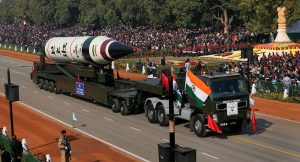https://bharatshakti.in/better-buying-power-for-defence-acquisitions-in-india/
Editor’s Note
We have already run an article on the acquisition process in UK by Lt Gen PR Shankar (Retired). In this article the author takes a look at the model in use in USA. Central to the acquisition model in the US is the knowledge level of the staff entrusted such reponsibilities. They have a University to impart knowledge on acquisitions. The General also identifies other core thrusts in the American system and arrives at a few areas that require focus in our case.
BETTER BUYING POWER FOR DEFENCE ACQUISITIONS IN INDIA
USA has a program called Better Buying Power (BBP) which talks of ‘implementation of best practices to strengthen the Defence Department’s buying power, improve industry productivity, and provide an affordable, value-added military capability to the War fighter’. It aims to achieve greater efficiency through better acquisition processes and principles with a stronger emphasis on innovation, technical excellence and quality. It has seven focus areas.
* Improving the Professionalism of the Total Acquisition Workforce.

Image Courtesy: Uncommon USA
* Elimination of Unproductive Processes and Bureaucracy
* Promoting Competition
* Incentivising Productivity & Innovation in Industry and Government
* Achievement of affordable programs.
* Controlling Costs throughout the Product Lifecycle.
* Improvement of Tradecraft in Acquisition of Services.
These focus areas are subjects by themselves. Hence, only four of them which are considered basic to our context will be discussed; namely – Improving Professionalism, Elimination of Unproductiveness, Promoting Competition and Innovation. Interestingly, the concept has been picked from the Defence Acquisition University website. USA has a university to educate and support its defence acquisition processes. The first lesson to learn, is that education is important.
Focus Areas Basic in Our Context
Improving professionalism of the acquisition workforce has to start by inculcation of professionalism. The key drivers identified to improve professionalism are excellence, responsibility, integrity, and accountability. Additional drivers needed to inculcate professionalism are knowledge and continuity. In our system these attributes exist in pockets in varying degrees.
Knowledge and excellence are correlated factors. It is from one that the other develops and hence needs tackling together. For an acquisition professional it encompasses experience, education and training. This has to be holistic and cover the entire field of acquisition. A good soldier cannot always be good in acquisitions. Similarly a good bureaucrat cannot always be good at acquisitions.
Experience is not military knowledge of handling weapons or administrative knowledge of handling files, processes and systems alone. It is a combination of both along with hands on experience of handling cases. This has to be reinforced by good education and most importantly honed by focused training. Hence, training our professionals is a first step.

Image Courtesy: Associated Press
Training has to ensure that acquisition professionals have cross-functional competencies encompassing fields like Executive Leadership, Program Execution, Technical Management and Business Management. However, there has to be a degree of specialisation also. Specialised fields could be acquisition processes, management of R&D activities, understanding and mitigation of risk, Science, Technology, Engineering and Mathematics associated with defence requirements, standards expected of acquisition key leaders, management practices for acquisition, quality control, defence financial management et al. A full range exists. Training courses can be drawn out. However it’s most important to put in a structure which can impart such training, post haste. We cannot keep waiting for the National Defence University to come up!
Everyone understands responsibility and integrity but these issues are often not fully understood. Any acquisition official is fully aware of these issues in the context of transparency and probity. But how about responsibility and integrity to serving the personnel who are expected to fight for the nation by laying their lives on the line. It’s our responsibility to the man in the combat zone to equip him optimally for the onerous task he has to do. Our integrity is best tested when his needs are met. The best gun, fighter aircraft, warship should be in his hands to defend the nation.
Continuity of the acquisition professional can only be ignored at peril. This has been done for far too long. Probity, career management, growth and all related issues can be put in place if we are convinced that continuity is a must. If acquisitions have to progress well there is no escaping from this fact. The only note of caution here is that continuity can be the cause of stagnation also and could be an obstacle. In such cases weeding out should be resorted to.
The bitter pill is accountability or the utter lack of it. Never in the history of independent India has a single official ever been taken to task for lack of delivery on time. Why? Lack of accountability? We do not have a rudimentary system which seeks and imposes accountability. There is severe lack of monitoring and review mechanisms in the entire chain. Our quality factors are subvert-able and our contracting mechanisms are weak. Lack of accountability is holistic and endemic – bureaucratic, service, scientific, industrial and financial. Accountability in our context only refers to transparency and probity. As a result risk taking ability is poor. Playing safe is the order of the day and decision making is best done collectively. The safest decision being not to take one at all.

Image Courtesy: DRDO
Elimination of unproductive processes and bureaucracy has to be the next priority in our context. It is a given that acquisition time cycles are long and need time to mature, especially in the case of major programs. However, processes cannot twist the whole thing out of shape. Any requirement from concept stage to definition stage gets convoluted and rigid. From there to realisation is another loop which is full of holes, pulls, pressures and compromises.
From realisation to production to induction is a different loop with a different bureaucracy. By the time this happens there are good chances that what is being acquired is not what was intended. In most cases these loops are poorly connected and agencies dealing with each loop have their own view and processes. Every acquisition gets subjected to a different process at various stages in its life cycle. Simply put ‘womb to tomb’ is pretty alien to our defence acquisition process at present.
The other major problem of our process is that the time cycles and processes are the same for all items irrespective of importance, size, shape, volumes or value. We have no process to prioritise or fast track an acquisition. Existing fast track processes fail to deliver. The net result is high degree of rigidity and a low degree of delivery in the system.
One of the biggest problems with our bureaucratic process is that programs shuttle up and down. We need to realise that our bureaucratic processes resist change and are prone to increase loop lines. In essence, we have a bureaucracy which delivers in fits and starts. We need to have a system which can deliver. The US Government model has processes and bureaucracy that are far more complex and demanding. But, it delivers. The only answer is a professional acquisition system with knowledge of what it is doing. So we go back to our first point – knowledge.

Image Courtesy: Twitter
Inculcating competitiveness is a very powerful idea in the context of defence acquisitions. For the US Government it is the single most powerful tool to drive productivity. In our context well entrenched and deep rooted government owned research and production entities have to be levered out of their monopoly regimes. While one part of the government talks of and is eager to open its institutions to competition, another part of the government is mandated to promote the same monopoly due to social factors which fosters incompetence. The Government of the day has to take a balanced call. In any outcome, corporatisation of defence production and widening private participation is a must to improve buying power.
Innovation, technical excellence and quality are great concepts to talk of. In our system they are rarely practiced. Incentives for better products is alien. To implement these concepts we need in depth knowledge. knowledge is also needed for an overhaul of the system. One often hears – our systems are well established and should not be changed for the sake of change. Well, our time tested and established systems have not delivered. So there is a need for change. If this is not a convincing argument, none is. Change carries risk. We should have the courage to take it. Change has also to be seen in the capacity to change. We cannot end up in a system where we were better off by not changing. The whole thing comes back to knowledge. If we are not knowledgeable we cannot ensure a balanced change.
The Poser
Lastly a line in the US Government publication says: “the system has many highly qualified acquisition leaders, but the bench is not deep enough”. In our system we have very few qualified acquisition personnel – The bench is near empty. Time to do something about it.
Lt Gen PR Shankar (Retd)
(Disclaimer: The views and opinions expressed in this article are those of the author and do not necessarily reflect the official policy or position of BharatShakti.in)

Comments
Post a Comment